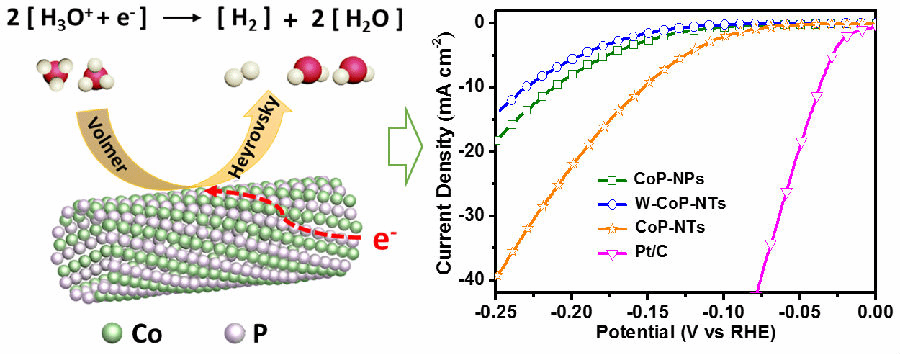Engineering a nanotubular mesoporous cobalt phosphide electrocatalyst by the Kirkendall effect towards highly efficient hydrogen evolution reactions. Yue-E Miao,* Fei Li, Yu Zhou, Feili Lai, Hengyi Lu and Tianxi Liu*.Nanoscale, 2017, 9, 16313.
[ pdf]
pdf]

Tailoring the size and controlling the morphology of particular nano-architectures are considered as two
promising strategies to improve the catalytic performance of metal nanocrystals towards hydrogen evolution
reactions (HERs). Herein, mesoporous cobalt phosphide nanotubes (CoP-NTs) with a three-dimensional
network structure have been obtained through a facile and efficient electrospinning technique
combined with thermal stabilization and phosphorization treatments. The thermal stabilization process
has been demonstrated to play a key role in the morphological tailoring of Co3O4 nanotubes (Co3O4-
NTs). As a result, the CoP-NTs show one-dimensional hollow tubular architecture instead of forming a
worm-like tubular CoP structure (W-CoP-NTs) or severely aggregated CoP powder (CoP-NPs) which
originate from the Co3O4 nanotubes without thermal stabilization treatment and Co3O4 nanoparticles,
respectively. Satisfyingly, under an optimized phosphorization degree, the CoP-NT electrode exhibits a
low onset overpotential of 53 mV with a low Tafel slope of 50 mV dec−1 during the HER process.
Furthermore, the CoP-NT electrode is capable of driving a large cathodic current density of 10 mA cm−2at an overpotential of 152 mV, which is much lower than those of its contrast samples, i.e. CoP-NPs
(211 mV) and W-CoP-NTs (230 mV). Therefore, this work provides a feasible and general strategy for constructing
three-dimensionally organized mesoporous non-noble metal phosphide nanotubes as promising
alternative high-performance electrocatalysts for the commercial platinum ones.